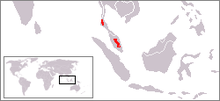- Malayan tiger
-
This article is about a tiger subspecies. For Japanese Imperial Army general who has the nickname "Malayan Tiger" or "Tiger of Malaya", see Tomoyuki Yamashita.
Malayan Tiger 
Conservation status Scientific classification Kingdom: Animalia Phylum: Chordata Class: Mammalia Order: Carnivora Family: Felidae Genus: Panthera Species: P. tigris Subspecies: P. t. jacksoni Trinomial name Panthera tigris jacksoni
Luo et al., 2004
Range map The Malayan tiger (Panthera tigris jacksoni, Malay: harimau belang) is a subspecies of tiger found in the southern and central parts of the Malay Peninsula.[2] Until 2004, it was not considered a subspecies in its own right. The new classification came about after a study by S. J. Luo et al. from the Laboratory of Genomic Diversity, part of the United States National Cancer Institute.
Recent counts showed there are 600–800 Malayan tigers in the wild, making it the most common tiger subspecies other than the Bengal and perhaps also the Indochinese tigers. It is nevertheless an endangered subspecies.
Contents
Physical characteristics
The Malayan tiger, along with the Sumatran tiger, is perhaps the smallest extant subspecies of tiger. Its stripe pattern is similar to the Indochinese tiger but its size is closer to the Sumatran tigers, with an average weight of 120 kilograms (260 lb) for adult males and 100 kg (220 lb) for females.[3] Male Malayan tigers measure around 237 centimetres (93 in) in length from head to tail and female Malayan tigress around 200 cm (79 in) in length.
Diet and biology
Malayan tigers prey on sambar deer, barking deer, wild boar, bearded pigs and serow. Tigers in Taman Negara also prey on sun bear and elephant calves. Whether their principal prey includes adult gaur and tapir is unknown. Occasionally, livestock is also taken; however, tiger predation reduces the numbers of wild boar which can become a serious pest in plantations and other croplands. Studies indicate that in areas where large predators (tigers and leopards) are extinct, wild pigs are over 10 times more numerous than in areas where tigers are still present.[4][5][6]
Tigers occur at very low densities 1.1–1.98 tigers per 100 km² in the rainforest as a result of low prey densities, thus in order to maintain viable tiger populations of minimum of 6 breeding females, reserves need to be larger than 1000 km². Biological/ecological research on the Malayan tiger is still in infancy. For example, information on dietary preference, morphological measurements, demographic parameters, social structure, communication, home range sizes, dispersal capabilities are all lacking.[2]
Captive
A genetic analysis of the phylogeny of tigers in 2004 split the Indochinese subspecies into two distinct subspecies: the Indochinese tiger and the Malayan tiger and the authors argue that the captive populations for these two subspecies should be managed in a similar way to the other recognized subspecies but it is unclear how this information will be used by the zoo community.
Naming controversy
When the Malayan tiger was accepted as a subspecies of the tiger family, the news was warmly received in Malaysia. However, there was soon debate over the scientific naming of the Malayan tiger. The formal description of the subspecies gave it the name Panthera tigris jacksoni in honour of tiger specialist Peter Jackson.[7]
However, the Malaysian Association of Zoological Parks and Aquaria (MAZPA) and the Government of Malaysia protested, arguing that Malaysia should have been consulted over the naming of its national icon.[8] Malaysia holds that the naming should reflect the geographical region, Malaysia. In Malaysia, therefore, the Malayan tiger is known as Panthera tigris malayensis.[citation needed]
Malaysian national icon
The Malayan tiger is depicted in the coat of arms of Malaysia, symbolising the government and appears in various heraldry of Malaysian institutions such as Royal Malaysian Police, Maybank, Proton and FAM. It symbolizes bravery and strength to Malaysians. It is also the nickname for the Malaysian national football team. The tiger has been given various nicknames by Malaysians, notably "Pak Belang," which literally means "Uncle Stripes." Pak Belang features prominently in folklore as one of the adversaries of Sang Kancil (the mouse deer).
The Malayan tiger was featured on Special Service Group insignia.
References
- ^ Kawanishi, K.; Lynam, T. (2008). "Panthera tigris subsp. jacksoni". IUCN Red List of Threatened Species. Version 3.1. International Union for Conservation of Nature. http://www.iucnredlist.org/apps/redlist/details/136893. Retrieved July 19, 2011.
- ^ a b Save The Tiger Fund: Malayan Tiger
- ^ WWF - Malayan tiger
- ^ Yong, D. L.; Lee, P. Y.-H.; Ang, A.; and Tan, K. H. (2010). "The status on Singapore island of the Eurasian wild pig Sus scrofa (Mammalia: Suidae)" (PDF). Nature in Singapore 3: 227–237. http://rmbr.nus.edu.sg/nis/bulletin2010/2010nis227-237.pdf.
- ^ Ickes, Kalan; Paciorek, Christopher J.; Thomas, Sean C. (2005). "Impacts of nest construction by native pigs (Sus scrofa) on lowland Malaysian rain forest saplings" (PDF). Ecology 86 (6): 1540–1547. JSTOR 3450779. http://www.forestry.toronto.edu/thomas/Ickes.et.al.Ecology.2005.pdf.
- ^ Ickes, Kalan (2001). "Hyper-abundance of native wild pigs (Sus scrofa) in a lowland dipterocarp rain forest of Peninsular Malaysia". Biotropica 33: 682–690. JSTOR 3593170.
- ^ "IUCN tiger specialist Peter Jackson earns his stripes". International Union for Conservation of Nature. June 7, 2005. http://www.iucn.org/about/work/programmes/species/news_events/?3487/IUCN-Tiger-Specialist-Peter-Jackson-Earns-His-Stripes. Retrieved July 19, 2011.
- ^ "Malayan tiger may get new name". NST. November 4, 2004. http://www.jphpk.gov.my/English/Nov04%204i.htm.
- General references
- Luo, Shu-Jin; Kim, Jae-Heup; Johnson, Warren E.; van der Walt, Joelle; Martenson, Janice et al. (2004). "Phylogeography and genetic ancestry of tigers (Panthera tigris)". PLoS Biology 2 (12): e442. doi:10.1371/journal.pbio.0020442. PMC 534810. PMID 15583716. http://biology.plosjournals.org/perlserv?request=get-document&doi=10.1371/journal.pbio.0020442.
External links
Categories:- IUCN Red List endangered species
- Endangered species
- Tigers
- Mammals of Thailand
- Carnivora of Malaysia
- National symbols of Malaysia
Wikimedia Foundation. 2010.

